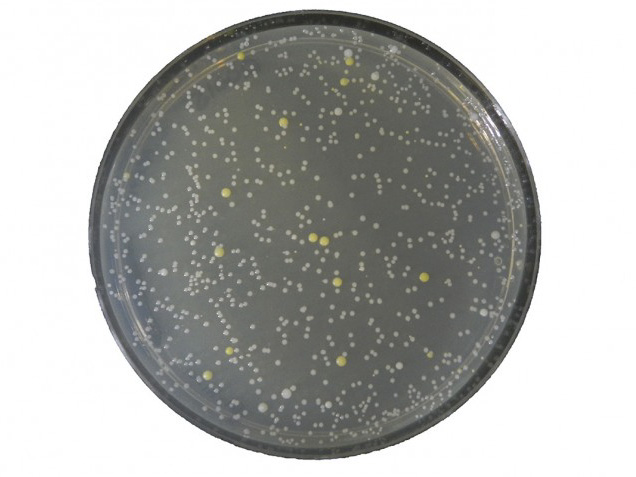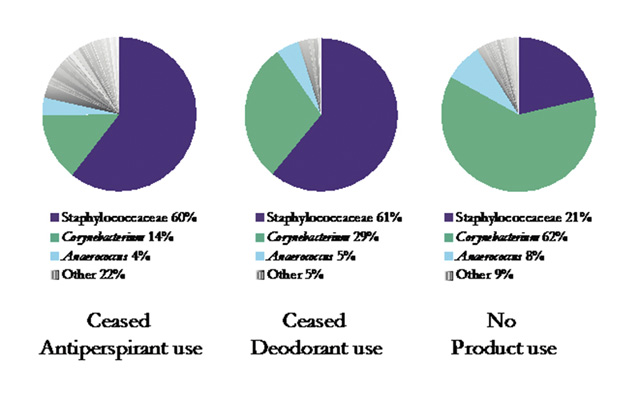Antiperspirant alters the microbial ecosystem on your skin
For immediate release ‐ February 02, 2016
Contact: Julie Horvath, 919.707.8242 and Julie Urban, 919.707.9286. Images available upon request
Additional Contacts:
Rob Dunn | 919.513.7569
Matt Shipman | 919.515.6386

Cultured bacteria from one of the samples in the study. Photo credit: Dawn Stancil, North Carolina Central University.
Wearing antiperspirant or deodorant doesn’t just affect your social life, it substantially changes the microbial life that lives on you. New research finds that antiperspirant and deodorant can significantly influence both the type and quantity of bacterial life found in the human armpit’s “microbiome.” The work was done by researchers at North Carolina State University, the North Carolina Museum of Natural Sciences, North Carolina Central University, Rutgers University and Duke University.
“We wanted to understand what effect antiperspirant and deodorant have on the microbial life that lives on our bodies, and how our daily habits influence the life that lives on us,” says Julie Horvath, head of the genomics and microbiology research laboratory at the NC Museum of Natural Sciences, an associate research professor at NC Central, and corresponding author of a paper describing the work published in the journal PeerJ. “Ultimately, we want to know if any changes in our microbial ecosystem are good or bad, but first we have to know what the landscape looks like and how our daily habits change it.”
“Thousands of bacteria species have the potential to live on human skin, and in particular in the armpit,” says Rob Dunn, a professor of applied ecology at NC State and co-author of the paper. “Just which of these species live in any particular armpit has been hard to predict until now, but we’ve discovered that one of the biggest determinants of the bacteria in your armpits is your use of deodorant and/or antiperspirant.”
“Within the last century, use of underarm products has become routine for the vast majority of Americans,” says Julie Urban, co-author of the paper, assistant head of the genomics and microbiology laboratory at the NC Museum of Natural Sciences, and adjunct professor of entomology at NC State. “Yet, whether use of these products favors certain bacterial species – be they pathogenic or perhaps even beneficial – seems not to have been considered, and remains an intriguing area needing further study.”
To learn about the microbial impact of antiperspirant and deodorant, the researchers recruited 17 study participants: three men and four women who used antiperspirant products, which reduce the amount we sweat; three men and two women who used deodorant, which often includes ethanol or other antimicrobials to kill off odor-causing microbes; and three men and two women who used neither product. They then launched an eight-day experiment, in which all of the participants had swabs taken of their armpits between 11 a.m. and 1 p.m.
On day one, participants followed their normal hygiene routine in regard to deodorant or antiperspirant use. On days two through six, participants did not use any deodorant or antiperspirant. On days seven and eight, all participants used antiperspirant.
The researchers then cultured all the samples to determine the abundance of microbial organisms growing on each participant and how that differed day to day.
“We found that, on the first day, people using antiperspirant had fewer microbes in their samples than people who didn’t use product at all – but there was a lot of variability, making it hard to draw firm conclusions,” Horvath says. “In addition, people who used deodorant actually often had more microbes – on average – than those who didn’t use product.”
By the third day, participants who had used antiperspirant were beginning to see more microbial growth. And by day six, the amount of bacteria for all study participants was fairly comparable.
“However, once all participants began using antiperspirant on days seven and eight, we found very few microbes on any of the participants, verifying that these products dramatically reduce microbial growth,” Horvath notes.
The researchers also did genetic sequencing on all of the samples from days three and six, to determine how antiperspirant and deodorant might affect the microbial biodiversity – the composition and variety of types of bacteria – over time.
They found that, among study participants who hadn’t worn deodorant or antiperspirant, 62 percent of the microbes they found were Corynebacteria, followed by various Staphylococcaceae bacteria (21 percent), with a random assortment of other bacteria accounting for less than 10 percent. Corynebacteria are partially responsible for producing the bad smells we associate with body odor, but they are also thought to help us defend against pathogens. Staphylococcaceae are a diverse group of bacteria that are among the most common microbes found on human skin and, while some can pose a risk to human health, most are considered beneficial.
The participants who had been regular antiperspirant users coming into the study had wildly different results. Sixty percent of their microbes were Staphylococcaceae, only 14 percent were Corynebacteria, and more than 20 percent were filed under “other” – meaning they were a grab-bag of opportunistic bacteria.
“Using antiperspirant and deodorant completely rearranges the microbial ecosystem of your skin – what’s living on us and in what amounts,” Horvath says. “And we have no idea what effect, if any, that has on our skin and on our health. Is it beneficial? Is it detrimental? We really don’t know at this point. Those are questions that we’re potentially interested in exploring.”
The new findings also highlight how human behavior can have a profound, if unintended, impact on the evolution of microbial organisms.
In another paper, published last month in Proceedings of the Royal Society B, the researchers, in addition to collaborators at Duke and the University of Pennsylvania, examined the diversity and abundance of microbes found in the armpits of humans, compared to other primates: chimpanzees, gorillas, baboons and rhesus macaques. In that paper, the researchers found that armpit microbes have evolved over time in conjunction with the primates they live on. But the microbial ecosystems found in the armpits of humans are vastly different – and far less diverse – than those found in our primate relatives.
“One exciting finding was that the non-human primates were more covered in fecal and soil associated microbes, which we often view as dirty,” Horvath says. “Perhaps the diversity of fecal and soil microbes on non-human primate skin serves some benefit that we don’t yet understand or appreciate.
“Over evolutionary time, we would expect our microbes to co-evolve with us,” Horvath says. “But we appear to have altered that process considerably through our habits, from bathing to taking steps to change the way we look or smell.”
The PeerJ paper, “The effect of habitual and experimental antiperspirant and deodorant product use on the armpit microbiome,” is under embargo and will be published at 7 a.m. EST on Feb. 2. The paper was co-authored by Daniel Fergus, Amy Savage, Megan Ehlers and Holly Menninger.
The paper was supported by the National Science Foundation, under grants 0953390 and 1319293; the U.S. Army Research Office, under grant W911NF-14-1-0556; and the Howard Hughes Medical Institute, under grant 52006933.
-shipman-
Note to Editors: The study abstract follows.
“The effect of habitual and experimental antiperspirant and deodorant product use on the armpit microbiome”
Authors: Julie Urban and Daniel J. Fergus, North Carolina Museum of Natural Sciences; Amy M. Savage, Rutgers University; Megan Ehlers, North Carolina State University and North Carolina Museum of Natural Sciences; Holly L. Menninger and Robert R. Dunn, North Carolina State University; and Julie E. Horvath, North Carolina Museum of Natural Sciences, North Carolina Central University, and Duke University
Published: Feb. 2, PeerJ
DOI: 10.7717/peerj.1605
Abstract: An ever expanding body of research is investigating the human microbiome in general and the skin microbiome in particular. Microbiomes vary greatly from individual to individual. Understanding the factors that account for this variation, however, has proven challenging, with many studies able to account statistically for just a small proportion of the inter-individual variation in the abundance, species richness or composition of bacteria. The human armpit has long been noted to host a high biomass bacterial community, and recent studies have highlighted substantial inter-individual variation in armpit bacteria, even relative to variation among individuals for other body habitats. One obvious potential explanation for this variation has to do with the use of personal hygiene products, particularly deodorants and antiperspirants. Here we experimentally manipulate product use to examine the abundance, species richness, and composition of bacterial communities that recolonize the armpits of people with different product use habits. In doing so, we find that when deodorant and antiperspirant use were stopped, culturable bacterial density increased and approached that found on individuals who regularly do not use any product. In addition, when antiperspirants were subsequently applied, bacterial density dramatically declined. These culture-based results are in line with sequence-based comparisons of the effects of long-term product use on bacterial species richness and composition. Sequence-based analyses suggested that individuals who habitually use antiperspirant tended to have a greater richness of bacterial OTUs in their armpits than those who use deodorant. In addition, individuals who used antiperspirants or deodorants long-term, but who stopped using product for two or more days as part of this study, had armpit communities dominated by Staphylococcaceae, whereas those of individuals in our study who habitually used no products were dominated by Corynebacterium. Collectively these results suggest a strong effect of product use on the bacterial composition of armpits. Although stopping the use of deodorant and antiperspirant similarly favors presence of Staphylococcaceae over Corynebacterium, their differential modes of action exert strikingly different effects on the richness of other bacteria living in armpit communities.


